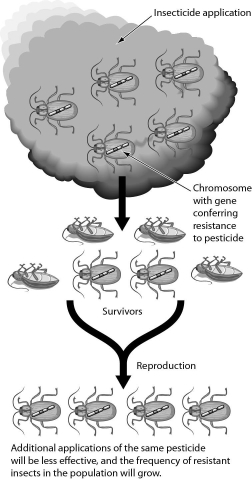A) The birth weight at which newborn humans are most likely to survive and the average weight of newborn humans are about the same.
B) There is an increase in antibiotic-resistant strains of bacteria.
C) There is an increase in the number of different breeds of dog.
D) Garter snakes with different coloration patterns behave differently when threatened.
Correct Answer

verified
Correct Answer
verified
Multiple Choice
Natural selection results in ______.
A) increased genetic variation
B) a population that is better adapted to a future environment
C) a population that is adapted to its current environment
D) an increase in the size of a population
Correct Answer

verified
Correct Answer
verified
Multiple Choice
The figure below shows what happens in insect populations when crops are sprayed with insecticides.This is an example of ______. 
A) natural selection
B) genetic drift
C) founder effect
D) gene flow
Correct Answer

verified
Correct Answer
verified
Multiple Choice
The similarity of the embryos of fish,frogs,birds,and humans is evidence of ______.
A) analogy
B) common ancestry
C) genetic drift
D) convergent evolution
Correct Answer

verified
Correct Answer
verified
Multiple Choice
The total collection of alleles in a population at any one time make up that population's ______.
A) gene pool
B) genotype
C) heterozygosity
D) polymorphic pool
Correct Answer

verified
Correct Answer
verified
Multiple Choice
After surviving a bottleneck,a population recovers to the point where it consists of as many individuals as it did prior to the bottleneck.Which of the following statements is most likely to apply to this population?
A) The postbottleneck population exhibits less genetic variation than the prebottleneck population.
B) The bottleneck subjected the population to stabilizing selection.
C) The postbottleneck population has less of a chance of going extinct than did the prebottleneck population.
D) The postbottleneck population exhibits more genetic variation than the prebottleneck population.
Correct Answer

verified
Correct Answer
verified
Multiple Choice
The founder effect differs from a population bottleneck in that the founder effect ______.
A) requires a small population
B) is a type of natural selection
C) can only occur on an oceanic island colony
D) involves the isolation of a small colony of individuals from a larger population
Correct Answer

verified
Correct Answer
verified
Multiple Choice
Which of the following is not a requirement of natural selection?
A) differential reproductive success
B) overproduction of offspring
C) genetic variation
D) catastrophic events
Correct Answer

verified
Correct Answer
verified
Multiple Choice
While on the Beagle,Darwin was influenced by a book by Charles Lyell that suggested that Earth was ______ and sculpted by geologic processes that ______ today.
A) old... continue
B) old... no longer occur
C) young... continue
D) young... no longer occur
Correct Answer

verified
Correct Answer
verified
Multiple Choice
The smallest biological unit that can evolve is the ______.
A) species
B) individual
C) population
D) phylum
Correct Answer

verified
Correct Answer
verified
Showing 41 - 50 of 50
Related Exams